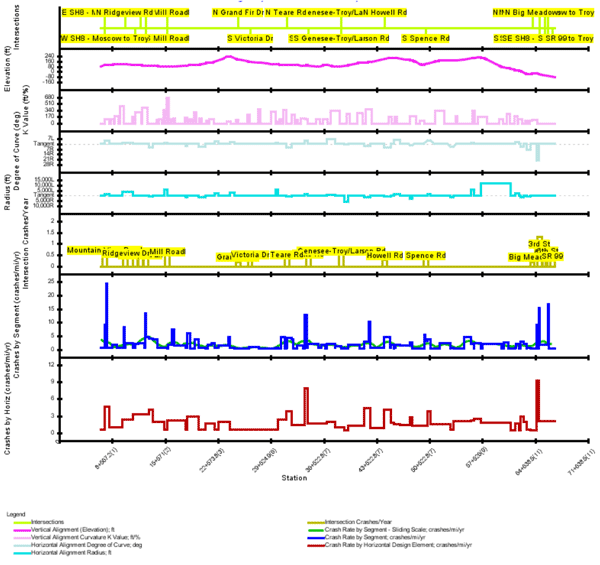HSM Reference
The Interactive Highway Safety Design Model (IHSDM) is a suite of software analysis tools developed by Federal Highway Administration’s (FHWA) Office of Safety Research and Development to evaluate safety and operational effects of geometric design decisions on highways. The IHSDM software includes a Crash Prediction Module that implements the Highway Safety Manual (HSM) Part C predictive methods for evaluating rural 2-lane highways, rural multilane highways and urban/suburban arterials. IHDSM may be downloaded free-of-charge on-line.
Description
The Idaho Transportation Department (ITD) contracted with a consultant to conduct a comprehensive review of existing Idaho State Highway 8 (Idaho 8) corridor conditions. The review identified deficiencies related to traffic operations, roadway geometry and cross section, access control, and safety with an overall purpose to identify and prioritize operational improvements over a 10-year period. FHWA’s IHSDM was used to evaluate existing traffic, roadway geometry, and predict crashes using these and the corridor’s recent crash history.

Discussion
The Idaho 8 Corridor Study evaluated approximately 11 miles of Idaho 8, from Moscow to Troy, Idaho. The corridor consists of a two-lane highway, characterized by rolling terrain traversing through primarily rural residential and agricultural development. Idaho 8 is classified as a minor arterial with current annual average daily traffic (AADT) ranging from 8,600 vehicles per day (vpd) at the west end of the corridor (Moscow); to 2,600 vpd at the east end (near Troy). The corridor has an average of five percent heavy vehicles.
Figure 1: Idaho 8: Corridor Study Area Map

Data used to build the IHSDM model provided by ITD included “as-built” plans, five years of historic crash data, video logs, traffic control, and existing and projected traffic volumes. These datasets were translated into a tabular format for incorporation into the Crash Prediction Module.
Figure 2: CPM Model Output: Crash Prediction Summary

The Crash Prediction Module (CPM) of the IHSDM implements the Highway Safety Manual predictive methods included in Part C for rural two-lane highways, rural multilane highways and urban/suburban arterials. Figure 2, above, is an example of the CPM for the Idaho 8 Corridor Study. The HSM Part D crash modification factors (CMFs) were used to compare effects of alternative mitigation strategies. A traffic operations review using the procedures outlined in the Transportation Research Board’s Highway Capacity Manual for two-lane highways supplemented this analysis.
The CPM required coding for each segment of highway as defined by horizontal and vertical geometry, lane and shoulder width, roadside hazard rating, driveway density, intersection type and location. Crashes were geo-referenced with the roadway geometry. For the 11 mile Idaho 8 project, the time to code the existing conditions and quality-check coding was approximately 100 hours of effort. The users encountered gaps in the availability of existing data. In most cases, the IHSDM accommodated these data gaps by providing default values. Quality control in data entry was critical. Users were alerted to inconsistencies when running the modules through issue summaries. Users were alerted to noticeable anomalies in geometric elements when referencing the map view in the program.
The CPM model output (seen in Figure 3) provides graphs and tables containing the expected number of crashes and frequencies for every highway element and at aggregated level. From the output Idaho officials found that more than half of the 11-mile corridor exhibited a calculated crash rate higher than the statewide average. The expected crash locations are a reflection of historic crash data and existing physical conditions within the corridor. This information was used to help isolate potential improvement locations. Once problematic locations were determined, contributing conditions were further examined to arrive at probable mitigation measures. The list of mitigation strategies were evaluated and prioritized based upon a variety of criteria including the likelihood of future crash reduction at these locations.
| First Year of Analysis | 2016 |
| Last Year of Analysis | 2020 |
| Evaluated Lenght (mi) | 11.39 |
| Average Future Road AADT (vpd) | 4,114 |
| Expected Crashes | |
|---|---|
| Total Crashes | 153 |
| Fatal and Injury Crashes | 56 |
| Fatal and Serious Injury Crashes | 36 |
| Property-Damage-Only Crashes | 96 |
| Percent of Total Expected Crashes | |
| Percent Fatal and Injury Crashes | 37% |
| Percent Fatal and Serious Injury Crashes | 24% |
| Percent Property-Damage-Only Crashes | 63% |
| Expected Crash Rate | |
| Crash Rate (crashes/mi/yr) | 2.68 |
| Fatal and Injury Crash Rate (crashes/mi/yr) | 0.99 |
| Fatal and Serious Injury Crash Rate (crashes/mi/yr) | 0.64 |
| Property-Damage-Only Crash Rate (crashes/mi/yr) | 1.69 |
| Expected Travel Crash Rate (crashes/millions veh-mi) | |
| Total Travel (million veh-mi) | 85.5 |
| Travel Crash Rate | 1.78 |
| Travel Fatal and Injury Crash Rate | 0.66 |
| Travel Fatal and Serious Injury Crash Rate | 0.42 |
| Travel Property-Damage-Only Crash Rate | 1.13 |
Training Needs
The project team received training to become familiar with the use and application of each of the six modules of the IHSDM. In addition to the CPM, this training included the Policy Review Module (PRM), Design Consistency Module (DCM), Traffic Analysis Module (TAM), Intersection Review Module (IRM) and Driver-Vehicle Module (DVM). Training sessions included detailed discussions about understanding the capabilities of each module, data input requirements, and interpretation of results. The ITD District Two staff provided data input and supported the IHSDM application on the corridor study.
Benefits
The Idaho 8 Corridor Study was completed in 2010 within a 10-month time span. While the IHSDM is a data intensive program, the time and effort invested in data entry is rewarded through the production of a vast amount of detailed data output from the modules. Data required to run the IHSDM CPM module are the same data required to run HSM predictive methods. All IHSDM modules, except the IRM, were run as part of the alternative analysis. Of these five modules, the IHSDM PRM and CPM modules were the most useful in identifying existing geometric deficiencies, specific locations needing further evaluation, or locations needing possible design improvements, and potential safety issues. IHSDM software produced a variation of graphical outputs for each review, which were modified to meet specific data or formatting needs.
Recommended mitigation measures consisted of access management strategies, development of passing lanes, increased intersection capacity, sight distance improvements, roadside safety enhancements, intelligent transportation system (ITS) applications, and development of animal crossings. A Corridor Plan Report was prepared to document the review, analysis, and resulting recommendations of this study to be included in the Statewide Transportation Improvement Program (STIP) for future implementation.
“The advantage of employing IHSDM on this project was the opportunity to perform a detailed and simultaneous review within the corridor on a variety of critical elements (that is, traffic operations, geometry, safety) to isolate potential problem areas and allow development of strategic mitigation strategies.”
– Bob Beckman, Project Manager
Contact
Ken Helm
Senior Transportation Planner
Idaho Department of Transportation
(208) 799-4229
ken.helm@itd.idaho.gov
Page last modified on October 15, 2014
